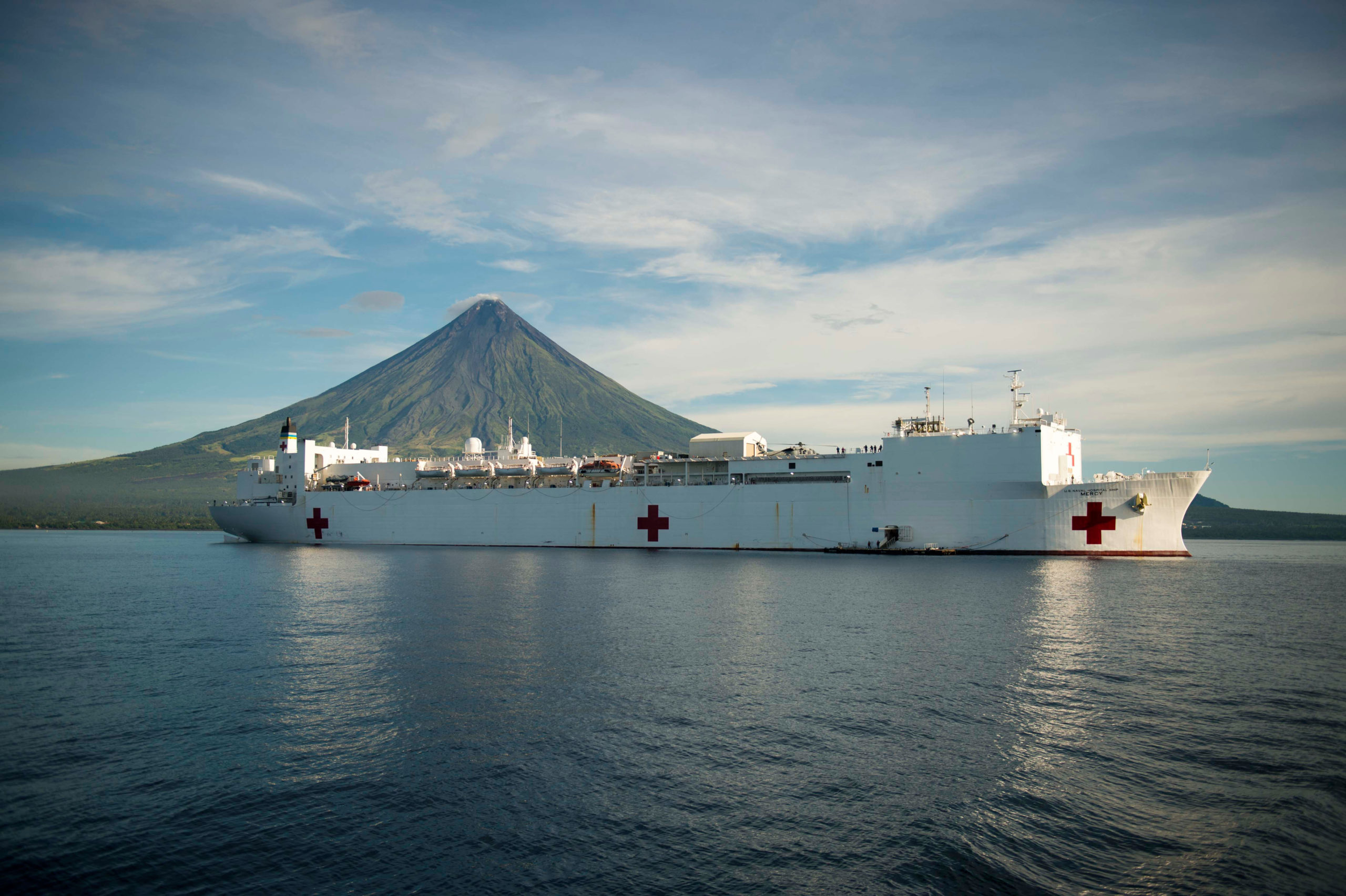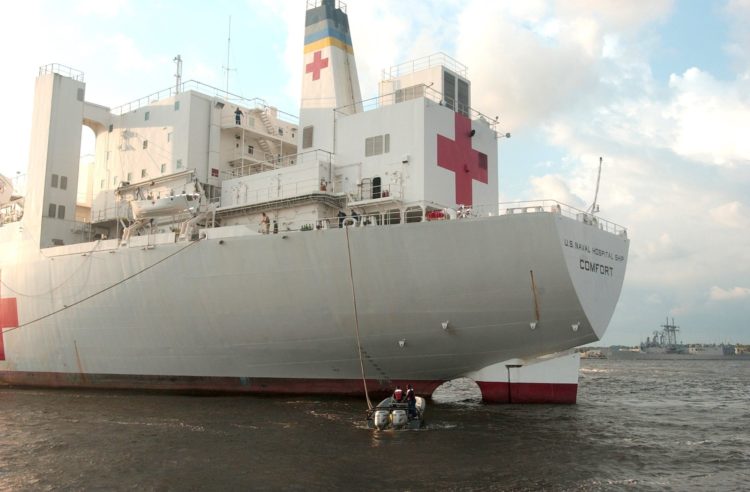Hospital ships open their doors to anyone who requires medical assistance (only if activated) per the second Geneva Convention of 1906 and the Hague Convention of 1907. In accordance with these, hospital ships and everybody on board enjoy a special status that protects them from any attack as long as it observes the restrictions stated in the conventions. Below are some of the conditions outlined in Article Four of the Hague Convention X:
- Ships must be clearly marked and lighted as a Hospital Ship;
- Ships should give medical assistance to wounded personnel of ALL nationalities;
- Ships must NOT be used for any military purpose;
- Ships must NOT interfere with or hamper enemy combatant vessels;
- Belligerents, as designated by the Hague Convention, can search any hospital ship to investigate violations of the above restrictions;
- Belligerents will establish the location of a hospital ship.
The US operates two active hospital ships under the US Navy, managed by the Military Sealift Command (MSC) since the 1980s. Since the vessels are non-commissioned properties, they’re given the prefix USNS or the United States Naval Ship instead of the USS (United States Ships).
Converted Oil Tankers
The USNS Mercy is the third largest ship in the US Navy Fleet by length and is the third ship to carry the name Mercy. Shipbuilding company NASSCO initially built USNS Mercy as a San Clemente-class super tanker (SS Worth MA-299) in June 1974 but was later converted to a hospital ship for a price tag of more than $208 million. After 35 months, Mercy was finally commissioned into service in the US Navy, dating November 8, 1986. As a leading hospital ship of her class up to date, the T-AH 19 features a raised forecastle, a transom stern, a bulbous bow, an extended deckhouse with a forward bridge, and a helicopter-landing deck with a flight-control facility.

On the other hand, the USNS Comfort came months after her sibling was built, and just like Mercy, Comfort was built as a San Clemente-class oil tanker (SS Rose City MA-301) with its keel first laid down in May 1975. The hospital ship was handed over to the US Navy and commissioned on December 1, 1987, more than a year after its conversion.
Both ships boast a hospital bed capacity of 1,000 with a military cadre crew of up to eight Officers and 53 Enlisted personnel and a civilian marine cadre crew of about 15 personnel while in a Reduced Operating Status (ROS).
These hospital ships were in service since the mid-to-late 1980s to provide medical and surgical services for the US military deployed ashore and afloat. It can also support government agencies in times of disaster and humanitarian relief missions and other peacetime military operations across the globe.
USNS Hospital Ships’ Technical Specifications:
- Length: 894 ft (272 m)
- Beam: 106 ft (32 m)
- Displacement: 69,552 tons
- Propulsion: Two boilers, two GE turbines, one shaft, and up to 24,500 hp (18.3 MW)
- Speed: 17 knots (Mercy); 17.5 knots (Comfort)
- Civilian: up to 71
- Military: up to 1,200
- Time to activate: at least five days
USNS Mercy lay berthed at Pier 1 on Naval Base San Diego, California, while USNS Comfort’s homeport is on Naval Station Norfolk, Virginia. A small crew of civil service mariners and Navy personnel maintain these ships while docked at the ports to ensure that it remains in a high state of readiness.
US Hospital Ships’ At Your Service
In 1987, four months following her deployment, Mercy set sail en route to the Philippines and the South Pacific to begin training. Aboard her were active personnel from the different service branches of the US military, staff from the American health sector, medical providers from the Philippine armed forces, and civilian mariners under the MSC. On that tour, tens of thousands of outpatients and hundreds of inpatients were treated before she returned to Oakland in July 1987.
Among the first post-training missions Mercy was her participation in Operation Desert Shield in 1990. She arrived in the Persian Gulf to provide medical support to the US armed forces and its international allies. During her active duty, she took in dozens of patients and performed nearly 300 surgeries. She hadn’t activated again until the 2000s when she was ordered to head to tsunami-ravaged Southeast Asia as part of Operation Unified Assistance following the massive Indian earthquake in 2004. Mercy then became a recurring ship in the Pacific Partnership, an annual deployment from the US Navy’s Pacific Fleet that aims to “improve the interoperability [within the allied forces] …during disaster relief operations, while providing humanitarian, medical, dental, and engineering assistance to nations of the Pacific.”

Like her big sister, Comfort also supported her during the Gulf War in 1990. During her deployment, she checked out over 8,000 outpatients and took aboard roughly 700 inpatients, including wounded Sailors, in a catastrophic steam accident on USS Iwo Jima (LPH-2) in October that year.
Living up to her name, Comfort also comforted hundreds of patients after successful surgical procedures every time she was activated for duty. In 1994, she participated in Operation Sea Signal and Operation Uphold Democracy. Then, in 2001, she participated in Operation Noble Eagle in the aftermath of the tragic 9/11 terrorist attack before sailing back to the Persian Gulf to serve as an afloat trauma center for injured patients during the Iraq War. Unlike Mercy, who spent most of her time administering to allied nations in the Asia Pacific, most of Comfort’s missions were set close to home.
In 2020, Mercy and Comfort were deployed to Port of Los Angeles and New York Harbor, respectively, to help the overwhelmed traditional hospitals in the country deal with the impact of the COVID-19 pandemic. The ship’s mission was to take in non-COVID-19 patients so that the land-based hospitals could solely focus on treating patients suffering from the virus.










COMMENTS
You must become a subscriber or login to view or post comments on this article.